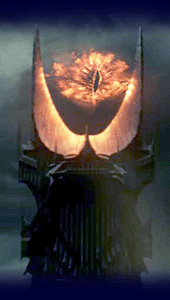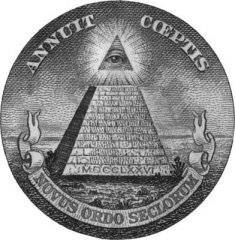

5. Sauron & Saruman. Biting the apple of knowledge
First of all, let us check who Saruman was through the words of the author. This
quoted fragment appears not much longer after the first time Saruman is
introduced in The Silmarillion:
Of these Curunir was the eldest and came first, and after him came Mithrandir
and Radagast, and others of the Istari who went into the east of Middle-earth,
and do not come into these tales. radagast was the friend of all beasts and
birds, but Curunir went most among Men, and he was subtle in speech and skilled
in all the devices of smithcraft. Mithrandir was closest in counsel with Elrond
and the Elves. He wandered far in the North and West and made never in any land
any lasting abode; but Curunir journeyed into the East, and when he returned he
dwelled in Orthanc in the Ring of Isengard, which the Númenóreans made in the
days of their power.
And these two are the translations Tolkien gave for his best known names:
Curunir 'The one of cunning devices', Elvish name of Saruman, one of the
Istari (Wizards) [Tolkien, The Silmarillion, 387]
Saruman 'Man of skill', the name among Men of Curunir (which it translates),
one of the Istari (Wizards) [Tolkien, The Silmarillion, 420]
Hitler was not skilled in arts and crafts. In fact Saruman is far more creative
than the Führer (though the latter tried to become a painter) And this point is
exactly where the relationship between Nazism and the Dark Enemy starts blurring
until it fades to black. Surprisingly enough, the powerful evil society in the
Lord of the Rings includes elements from another closer equivalent in history:
Masonry. The real main character in the book is the One Ring, a jewel made by
smithcraft, coming from the skill of Elven-smiths. Sauron became Annatar, the
Lord of Gifts, and made friends with the Noldor Elves at Eregion, who took him
as a master for the art of smithcraft. He taught them how to improve their
skills, and soon after the elves had made some rings, he had made an artifact
himself to seize power: the One Ring. After that, Elves discovered Sauron's true
intentions, and stood away from him, hiding the rings so he couldn't recover
them to dominate Middle-earth. The One Ring was lost in a battle, and remained
forgotten for a thousand years. Later on, Saruman, the first and wisest Istari
to arrive in Middle-earth starts studying the Ring Lore to find the Ring, and
meanwhile he gathered an army and developed many mechanical devices, mostly
weapons made from wood and steel. Isengard becomes an iron-factory like the
first industrial city built by Krupp in Germany in the early 20th century. Free
peoples of Middle-earth are commanded by nature-loving chiefs, skilled in trees
and plants, whereas the Enemy is skilled in machinery. Hunger for technical
knowledge turns Saruman into a selfish tyrant. Concerning Masonic history, we
are told about a mythical founder dating from the age of King Solomon, Hiram
Abiff:
According to the author of the Second Book of Chronicles (Chap. ii.) Solomon
sent messengers to Hiram, King of Tyre, to acquaint that friendly sovereign with
the fact that he contemplated erecting a Temple, and inviting him to furnish men
and materials for the prosecution of the work. Solomon's first demand was for a
specially gifted craftsman.
"Send me now," he says, "a man cunning to work in gold, and in silver, and in
brass, and in iron, and in purple, and crimson, and blue, and that can skill to
grave with the cunning men that are with me in Judah, and in Jerusalem:"
The King of Tyre received the embassy with cordiality, and returned a.
favourable answer to Solomon.
"I have sent a cunning man," he says, "endued with understanding. . . The son of
a woman of the daughters of Dan, and his father was a man of Tyre."
The account given. in the First Book of the Kings (Chap. VII.) differs somewhat
so far as the parentage of the man is concerned. There it is stated that he was
"a widow's son of the tribe of Naphtali." The author or editor of Kings agrees
with the Chronicler that Hiram's father was a Tyrian, adding that he was "a
worker in brass." Josephus describes him as of Naphtali on his mother's side,
his father being Ur of the stock of Israel. It is not easy to reconcile these
differences. One Biblical student - Giesebrecht - suggests that the dislike felt
by the editor of Kings to the idea of the Temple being built by a half-Phoenician
caused him to insert the words "a widow of the tribe of Naphtali," the
alteration of the phrase "of the daughters of Dan" into "of the tribe of
Naphtali," being the more permissible, since Dan lay in the territory of
Naphtali.
The clear points that emerge are that Hiram was of mixed race, the son of a
brassworker, and a man so high in his profession as to have secured the
patronage of his King, and to have been deemed worthy to uphold the reputation
of his country. His exalted position is inferred from the description given by
the author of the Chronicles who alludes to him as "Hiram Abi," and the word "Abi,"
meaning "my father," is usually taken in the sense of "master," a title of
respect and distinction.
The name is undoubtedly Phoenician, but there is some confusion, as to its
actual form. "Hiram" is the more common rendering, but the author of the
Chronicles adheres to the spelling "Huram," and other writers adopt the variant
"Hirom." Mr J. F. Stenning says that it is equivalent to "Ahiram," and means "the
exalted one." According to Movers, Hiram or Huram. is the name of a deity, and
means "the coiled or twisted one," but other scholars regard this derivation as
very improbable.
[...]
The editors of "The Jewish Encyclopaedia " point out that there is an
essential difference as regards the nature of his technical specialty between
the account preserved in the First Book of Kings and that in the Second Book of
Chronicles. According to the former, Hiram was an artificer only in brass, and
the pieces which he executed for the Temple were the two pillars, Jachin and
Boaz, the molten sea with its twelve oxen, the ten layers with their bases, the
shovels and basins, all of brass. But in the Second Book of the Chronicles he is
depicted as a man of many parts, and the impression is conveyed that he
superintended all the work of the Temple. Josephus seeks to reconcile the two
accounts by saying that Hiram was expert in all sorts of work, but that his
chief skill lay in working in gold, silver and brass.
W. Harvey, Preface to The Story of Hiram Abiff (http://freemasonrywatch.org/hiramabiff.html)
Saruman (and Sauron at first) turns out to be the most highly skilled person in
smithcraft, and in Ring Lore, for he is literally 'a man of skill', 'of cunning
devices'. But at the end his purposes became a menace, as he earned for the
knowledge to allow him to find and control the One Ring. His wisdom was exalted
and it made him so proud of himself that he wanted knowledge to gain power and
become the One Lord. Ahiram was 'the exalted one', and in addition, if we pay
attention to the last translation for the name 'Hiram' given by Movers, it is
related to a god who was coiled or twisted. Both Sauron and Saruman were
powerful Maiar, and in the beginning they were good. But they twisted under the
power of the Ring.
Once again, Peter Jackson's screening of the book gives us a new perspective
about the interpretation of analogies and resemblances. Every time we travel
into the depths of Isengard, we are transported to an iron-factory, hearing the
clinking sound of hammered anvils and feeling the heat of iron-melting ovens and
burning yellow liquid. But when we travel to Mordor, we see a tall tower,
crowned by a single lidless eye wreathed in flames, as told by Tolkien. In 1776,
Adam Weishaupt reunited the Illuminati to gather the absolute power over
worldwide society, controlling government, economy, education and press (the
absolute control of knowledge and information in modern society) By now, we only
have a wicked magician and the incarnation of Satan in Middle-earth. But we also
have an absolutist government (the tyranny of Mordor), technicized industry (the
caves of Isengard) and the control and manipulation of information (the
Palantiri) And thanks to Jackson, we have images like these:


A tower crowned by an eye: the ultimate materialization of Sauron and the symbol of the Illuminati. About the second symbol, an unfinished pyramid, dark on the western-side crowned by the eye of God. Apparently an icon for the former United States and their Declaration of Independence agreed by the Continental Congress (a still incomplete nation sheltered by God, its western-lands to be discovered yet). Free Peoples of Middle-earth worship no idol nor icon. The Dark Lord is the master of evil, the eye-that-sees-everything, Orwell's Big Brother. The light coming into the eyes is wisdom, but sometimes what we see can fool us.
© 1996-2006, Universitat de València Press
© Ignacio Pascual Mondéjar, 2006
© a.r.e.a. & Dr.Vicente Forés